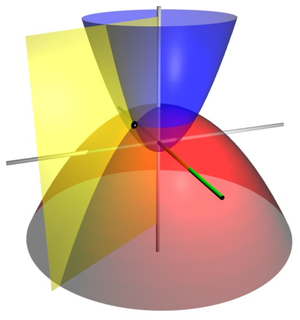- Paraboloidal coordinates
-
Paraboloidal coordinates are a three-dimensional orthogonal coordinate system (λ,μ,ν) that generalizes the two-dimensional parabolic coordinate system. Similar to the related ellipsoidal coordinates, the paraboloidal coordinate system has orthogonal quadratic coordinate surfaces that are not produced by rotating or projecting any two-dimensional orthogonal coordinate system.
 Coordinate surfaces of the three-dimensional paraboloidal coordinates.
Coordinate surfaces of the three-dimensional paraboloidal coordinates.
Contents
Basic formulae
The Cartesian coordinates (x,y,z) can be produced from the ellipsoidal coordinates (λ,μ,ν) by the equations
where the following limits apply to the coordinates
- λ < B < μ < A < ν
Consequently, surfaces of constant λ are elliptic paraboloids
and surfaces of constant ν are likewise
whereas surfaces of constant μ are hyperbolic paraboloids
Scale factors
The scale factors for the paraboloidal coordinates (λ,μ,ν) are
Hence, the infinitesimal volume element equals
Differential operators such as
 and
and  can be expressed in the coordinates (λ,μ,ν) by substituting the scale factors into the general formulae found in orthogonal coordinates.
can be expressed in the coordinates (λ,μ,ν) by substituting the scale factors into the general formulae found in orthogonal coordinates.References
Bibliography
- Morse PM, Feshbach H (1953). Methods of Theoretical Physics, Part I. New York: McGraw-Hill. p. 664. ISBN [[Special:BookSources/0-07-043316-X, LCCN 52-11515|0-07-043316-X, LCCN 52-11515]].
- Margenau H, Murphy GM (1956). The Mathematics of Physics and Chemistry. New York: D. van Nostrand. pp. 184–185. LCCN 55-10911.
- Korn GA, Korn TM (1961). Mathematical Handbook for Scientists and Engineers. New York: McGraw-Hill. p. 180. LCCN 59-14456, ASIN B0000CKZX7.
- Arfken G (1970). Mathematical Methods for Physicists (2nd ed. ed.). Orlando, FL: Academic Press. pp. 119–120.
- Sauer R, Szabó I (1967). Mathematische Hilfsmittel des Ingenieurs. New York: Springer Verlag. p. 98. LCCN 67-25285.
- Zwillinger D (1992). Handbook of Integration. Boston, MA: Jones and Bartlett. p. 114. ISBN 0-86720-293-9. Same as Morse & Feshbach (1953), substituting uk for ξk.
- Moon P, Spencer DE (1988). "Paraboloidal Coordinates (μ, ν, λ)". Field Theory Handbook, Including Coordinate Systems, Differential Equations, and Their Solutions (corrected 2nd ed., 3rd print ed. ed.). New York: Springer-Verlag. pp. 44–48 (Table 1.11). ISBN 978-0387184302.
External links
Orthogonal coordinate systems Two dimensional orthogonal coordinate systems Three dimensional orthogonal coordinate systems Cartesian coordinate system • Cylindrical coordinate system • Spherical coordinate system • Parabolic cylindrical coordinates • Paraboloidal coordinates • Oblate spheroidal coordinates • Prolate spheroidal coordinates • Ellipsoidal coordinates • Elliptic cylindrical coordinates • Toroidal coordinates • Bispherical coordinates • Bipolar cylindrical coordinates • Conical coordinates • Flat-ring cyclide coordinates • Flat-disk cyclide coordinates • Bi-cyclide coordinates • Cap-cyclide coordinates • Concave bi-sinusoidal single-centered coordinates • Concave bi-sinusoidal double-centered coordinates • Convex inverted-sinusoidal spherically-aligned coordinates • Quasi-random-intersection cartesian coordinatesCategories:- Coordinate systems
Wikimedia Foundation. 2010.










